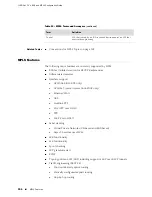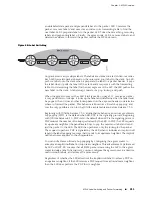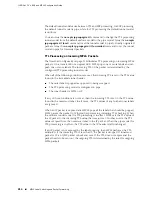
still use labels from that space unless you restrict them in turn to a different range
of interface labels.
In the interface label space, MPLS selects labels from interface resources, a VPI/VCI
combination. You configure a VPI range and a VCI range available to the labels. When
an upstream LSR requests a label, the downstream LSR allocates a VPI/VCI
combination for use as a label between these two peers. Allocating labels on a per
interface basis is necessary because the VPI/VCI ranges are limited. This enables you
to use the same label on different interfaces without conflict.
When you use the platform label space, the MPLS ingress node places labels in
shim
headers
between the link-layer header and the payload. The shim header includes
the following bits (Figure 50 on page 213):
■
Label bits—Twenty bits
■
EXP bits—Three bits for class of service information; these bits are variously
called the experimental bits, class of service (CoS) bits, or type of service (ToS)
bits. The EXP bits are mapped from the IP packet at the ingress node and are
mapped back into the IP packet at the egress node.
■
S bit—One bit to indicate whether the label is on the bottom of the label stack.
■
TTL bits—Eight bits for a time-to-live indicator. The TTL bits are mapped from
the IP packet at the ingress node. The TTL bits in the shim header are
decremented at each hop. The bits are mapped back into the IP packet at the
egress node. See “TTL Processing in the Platform Label Space” on page 213 for
more information.
Figure 50: Shim Header
If you configure an MPLS interface to use the interface label space, the VPI/VCI
combinations are used as labels, so there is no need to place them within a shim
header. As the data travels along the LSP, the LSRs examine only the VPI/VCI
combination. The shim header is used only to carry the TTL bits to the egress, and
is not visible to intermediate LSRs. The ingress node learns the total hop count from
signaling and then uses that count to decrement the TTL to the correct final value.
The TTL is then carried in the shim header to the egress node without modification,
arriving with the correct count.
TTL Processing in the Platform Label Space
JUNOSe MPLS TTL processing is compliant with RFC 3443. The details of TTL
processing vary with the tunnel model that is configured for TTL processing, pipe or
uniform.
To keep backward compatibility with earlier JUNOSe releases, you do not use the
mpls tunnel-model
command to configure the tunnel model for TTL processing,
That command is used instead to configure the tunnel model for EXP bits processing.
MPLS Label Switching and Packet Forwarding
■
213
Chapter 2: MPLS Overview
Summary of Contents for BGP
Page 6: ...vi ...
Page 8: ...viii JUNOSe 11 1 x BGP and MPLS Configuration Guide ...
Page 37: ...Part 1 Border Gateway Protocol Configuring BGP Routing on page 3 Border Gateway Protocol 1 ...
Page 38: ...2 Border Gateway Protocol JUNOSe 11 1 x BGP and MPLS Configuration Guide ...
Page 234: ...198 Monitoring BGP JUNOSe 11 1 x BGP and MPLS Configuration Guide ...
Page 236: ...200 Multiprotocol Layer Switching JUNOSe 11 1 x BGP and MPLS Configuration Guide ...
Page 542: ...506 Monitoring BGP MPLS VPNs JUNOSe 11 1 x BGP and MPLS Configuration Guide ...
Page 544: ...508 Layer 2 Services Over MPLS JUNOSe 11 1 x BGP and MPLS Configuration Guide ...
Page 610: ...574 Virtual Private LAN Service JUNOSe 11 1 x BGP and MPLS Configuration Guide ...
Page 624: ...588 VPLS References JUNOSe 11 1 x BGP and MPLS Configuration Guide ...
Page 680: ...644 Virtual Private Wire Service JUNOSe 11 1 x BGP and MPLS Configuration Guide ...
Page 724: ...688 Monitoring MPLS Forwarding Table for VPWS JUNOSe 11 1 x BGP and MPLS Configuration Guide ...
Page 725: ...Part 6 Index Index on page 691 Index 689 ...
Page 726: ...690 Index JUNOSe 11 1 x BGP and MPLS Configuration Guide ...
















































